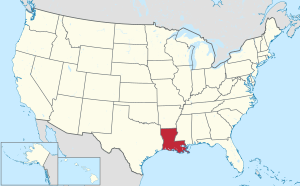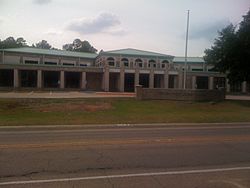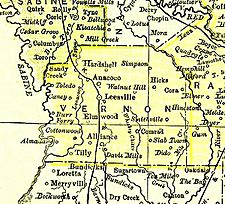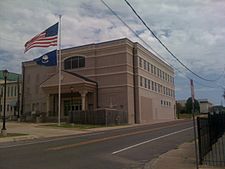Vernon Parish, Louisiana facts for kids
Quick facts for kids
Vernon Parish, Louisiana
|
|
|---|---|
| Parish of Vernon | |

Vernon Parish courthouse in Leesville
|
|

Location within the U.S. state of Louisiana
|
|

Louisiana's location within the U.S.
|
|
| Country | |
| State | |
| Region | Central Louisiana |
| Founded | March 30, 1871 |
| Named for | Mount Vernon |
| Parish seat | Leesville |
| Largest municipality | Simpson (area) Leesville (population) |
| Incorporated municipalities |
6 (total)
1 city, 3 towns, and 2 villages
(located entirely or partially within parish boundaries) |
| Area | |
| • Total | 3,470 km2 (1,341 sq mi) |
| • Land | 3,440 km2 (1,328 sq mi) |
| • Water | 40 km2 (14 sq mi) |
| • percentage | 3 km2 (1.0 sq mi) |
| Population
(2020)
|
|
| • Total | 48,750 |
| • Density | 14.036/km2 (36.353/sq mi) |
| Time zone | UTC-6 (CST) |
| • Summer (DST) | UTC-5 (CDT) |
| Area code | 337 |
| Congressional district | 4th |
Vernon Parish (French: Paroisse de Vernon) is a parish located in the U.S. state of Louisiana. As of the 2020 census, the population was 48,750. The parish seat and most populous municipality is Leesville. Bordered on the west by the Sabine River, the parish was founded in 1871 during the Reconstruction era.
It was long a center of the timber industry, which harvested pine in the hills and bottomland hardwoods. Construction of a railway to the area in 1897 stimulated the marketing of lumber and businesses in the area.
Since World War II, Fort Johnson, formerly Fort Polk, has been most important to the parish economy. The population of the Leesville area rapidly increased fivefold after the fort was opened. Vernon Parish is part of the Fort Johnson South, LA Micropolitan Statistical Area, which is also included in the DeRidder-Fort Johnson South, LA Combined Statistical Area.
Contents
History
On March 30, 1871, the Louisiana General Assembly passed an act designating the creation of Vernon Parish, by taking territory from the parishes of Natchitoches, Rapides, and Sabine. While there seem to be four stories surrounding the naming of the Parish, only one is affirmed officially by the State which is that it was named in honor of Mt. Vernon, the home of George Washington. Other stories, though folklore, are: 1) that it was named after a race horse owned by Joe Moore, one of the members of the committee chosen to name the parish, who claimed that by naming the parish after his fast horse the committee would insure the growth of the parish to be as fast as his horse: 2) that it was named after a popular teacher who had been an officer in the Royal Navy, only mentioned as "Mr. Vernon". This was not to honor him, but to avoid disputes among the parish founders whom each wanted to name the parish after themselves. The final story is similar to the first and claims that the committee had been arguing over the name while drinking in a store, and in an attempt to preserve his precious whiskey and profits, the host suggested the committee stop a local man with a mule pulling a cart and that they should name the parish whatever the man said. The man answered them "I calls him Vernon, 'cause he's the fastes' mule in de country." Originally the area comprising Vernon was a part of a tract of land that was in dispute between the United States and Spain, this land was called the "Neutral Strip". As a result of this dispute the area became a haven for outlaws. Prior to the Louisiana Purchase in 1803, the only persons who came to the area were a few French and Spanish settlers. It was also during this period that Dr. Timothy Burr, a Massachusetts native who had come to Louisiana from Mt. Vernon, Knox County, Ohio, established the community of Burr Ferry. This community was known as the "Gateway to Louisiana". Also located near this community, there still stands an artillery site (now called the "Confederate Breast Works"), which was manned by the Confederacy to guard against Union movements along the Nolan Trace during the Civil War.

Leesville has been the parish seat of Vernon since the parish was created, though it was not incorporated until February 15, 1900. The city, although founded by Dr. Edmund E. Smart, was named by Senator John Rowell Smart, his father, in honor of General Robert E. Lee. At the time of Leesville's founding, the site was the home of a plantation owned by Dr. Smart. The house from that plantation is still found today at the corner of Lula and First street.
In the late 1890s the timber industry, which was the dominant industry in the parish from its creation, began to boom with the arrival of the Kansas City Southern Railway in 1897, which is still in operation today.
In the period after World War I, Vernon became the site of two socialist based communities; the Llano del Rio Cooperative Colony (which became New Llano) established in 1917 and the Christian Commonwealth Colony. These colonies attempted to attract economists and sociologists for the purpose of conducting an experiment in communal membership and the sharing of labor duties. Of the two colonies the Llano del Rio was the largest with over 10,000 people and was also the longest surviving community. Both colonies failed in the 1930s when the depression hit.
In 1941, the United States Army opened Camp Polk, shortly after the 1939-40 maneuvers. Camp Polk quickly surpassed the timber industry as the dominant force in the parish's economy, which became evident in the parish seat of Leesville when its population jumped from 3,500 to 18,000 after the camp opened. The Camp receives its name from Leonidas Polk, the first Episcopal Bishop in Louisiana, known as the "Fighting Bishop of the Confederacy" and served as one of the major training camps during World War II. Today, now called Fort Polk is the 5th largest military installation in the nation, containing approximately 200,000 acres (800 km²). With the constant movement of soldiers and their dependents in and out of the parish, Vernon experiences a unique blend of culture from numerous states and countries creating a true "melting pot."
Geography
According to the U.S. Census Bureau, the parish has a total area of 1,341 square miles (3,470 km2), of which 1,328 square miles (3,440 km2) is land and 14 square miles (36 km2) (1.0%) is water. It is the largest parish in Louisiana by land area.
Major highways
Adjacent parishes and counties
- Sabine Parish (northwest)
- Natchitoches Parish (north)
- Rapides Parish (east)
- Allen Parish (southeast)
- Beauregard Parish (south)
- Newton County, Texas (west)
National protected area
- Kisatchie National Forest (part)
Demographics
| Historical population | |||
|---|---|---|---|
| Census | Pop. | %± | |
| 1880 | 5,160 | — | |
| 1890 | 5,903 | 14.4% | |
| 1900 | 10,327 | 74.9% | |
| 1910 | 17,384 | 68.3% | |
| 1920 | 20,493 | 17.9% | |
| 1930 | 20,047 | −2.2% | |
| 1940 | 19,142 | −4.5% | |
| 1950 | 18,974 | −0.9% | |
| 1960 | 18,301 | −3.5% | |
| 1970 | 53,794 | 193.9% | |
| 1980 | 53,475 | −0.6% | |
| 1990 | 61,961 | 15.9% | |
| 2000 | 52,531 | −15.2% | |
| 2010 | 52,334 | −0.4% | |
| 2020 | 48,750 | −6.8% | |
| U.S. Decennial Census 1790–1960 1900–1990 1990–2000 2010 |
|||
| Race | Number | Percentage |
|---|---|---|
| White (non-Hispanic) | 33,599 | 68.92% |
| Black or African American (non-Hispanic) | 6,325 | 12.97% |
| Native American | 484 | 0.99% |
| Asian | 862 | 1.77% |
| Pacific Islander | 289 | 0.59% |
| Other/Mixed | 3,016 | 6.19% |
| Hispanic or Latino | 4,175 | 8.56% |
As of the 2020 United States census, there were 48,750 people, 17,696 households, and 12,375 families residing in the parish.
Education

Primary and secondary education
All public schools in Vernon Parish are operated by the Vernon Parish School Board, which operates 18 public schools and one optional school.
Schools providing a secondary education include:
- Evans High School (Grades PK-12)
- Hicks High School (Grades PK-12)
- Hornbeck High School (Grades PK-12)
- Pitkin High School (Grades PK-12)
- Simpson High School (Grades PK-12)
- Anacoco High School (Grades 7–12)
- Pickering High School (Grades 7–12)
- Rosepine Junior/Senior High School (Grades 7–12)
- Leesville High School (Grades 9–12)
- Vernon Parish Optional School (Grades 7–12)
- Faith training Christian academy (private k4-12)
Colleges and universities
The Louisiana Technical College (LTC) system operates the Lamar Salter campus south of New Llano. The Central Louisiana Technical College Lamar Salter campus is one of 40 LTC campuses across the state.
Northwestern State University (NSU), is a four-year public university primarily situated in Natchitoches, Louisiana and is part of the University of Louisiana System. The NSU-Leesville/Fort Johnson Campus is located on Highway 467 near Fort Johnson. It serves the civilian communities of Vernon, Beauregard, and Sabine parishes, as well as the military community at Fort Johnson. http://leesville.nsula.edu/
The Fort Johnson Education Center offers self-development opportunities for Service members, military family members, Department of the Defense employees, military Retirees, Department of Defense contractors, and civilians from the local community in the classroom, distance learning, and online environments. Civilian students coming to the post for classes are required to use the main entrance located off U.S. Highway 171.
Central Michigan University (CMU) operates a campus at Fort Johnson.
Central Texas College (CTC) is a public, open-admission community college offering associate degrees and certificate programs in academic, professional and vocational/technical fields. Due to its proximity to Fort Johnson, CTC has evolved from a small junior college into a college catering to the military. CTC also help students transition from a 2-year to a 4-year degree through numerous articulation agreements with 4-year institutions nationwide.
Louisiana State University offers a Master of Arts in Liberal Arts.
The Upper Iowa University (UIU) at Fort Johnson offers classes on post to both military personnel and civilians in the area. It was opened in 1995 and offers bachelor's degrees in nine majors. Courses can also be blended with UIU distance learning programs (online and independent study) to complete 11 other majors. Certificate programs are also available. UIU offers courses on post during five eight-week terms during the academic year. All courses are offered during the evenings and on weekends.
Public libraries
The Vernon Parish Library operates public libraries. It operates the main library and the Dunbar Branch Library in Leesville and the Pitkin Branch Library in Pitkin.
National Guard
The Louisiana Army National Guard maintains a maintenance facility which services its vehicles on Fort Polk. 3-156 IB part of 256th Tiger Brigade is located at fort polk.
Communities
Cities
Towns
Villages
Census-designated places
Unincorporated communities
Notable people
- Bert A. Adams, state representative from Vernon Parish from 1956 to 1968
- Eddie Fuller, running back for the Buffalo Bills
- Frank A. Howard, former Vernon Parish sheriff and Republican member of the Louisiana House of Representatives
- Buddy Leach, former member of the United States House of Representatives, Louisiana House of Representatives, and Louisiana Democratic Party chairman
- Kevin Mawae, All-Pro center for the Tennessee Titans
- Demond Mallet, professional basketball player in the German League and with Joventut Badalona
- Jim McCrery, former U.S. Representative for Louisiana's 4th congressional district
- Charles M. Poston, Sr., member of the Louisiana State Senate from 1960 to 1964
- Bryan A. Poston, member of the Louisiana State Senate from 1964 to 1992
- Jewel Prestage, first African-American woman to earn a PhD in political science, former Dean of the School of Public Policy and Urban Affairs at Southern University
- D'Anthony Smith, nose tackle for the Chicago Bears
See also
 In Spanish: Parroquia de Vernon para niños
In Spanish: Parroquia de Vernon para niños




